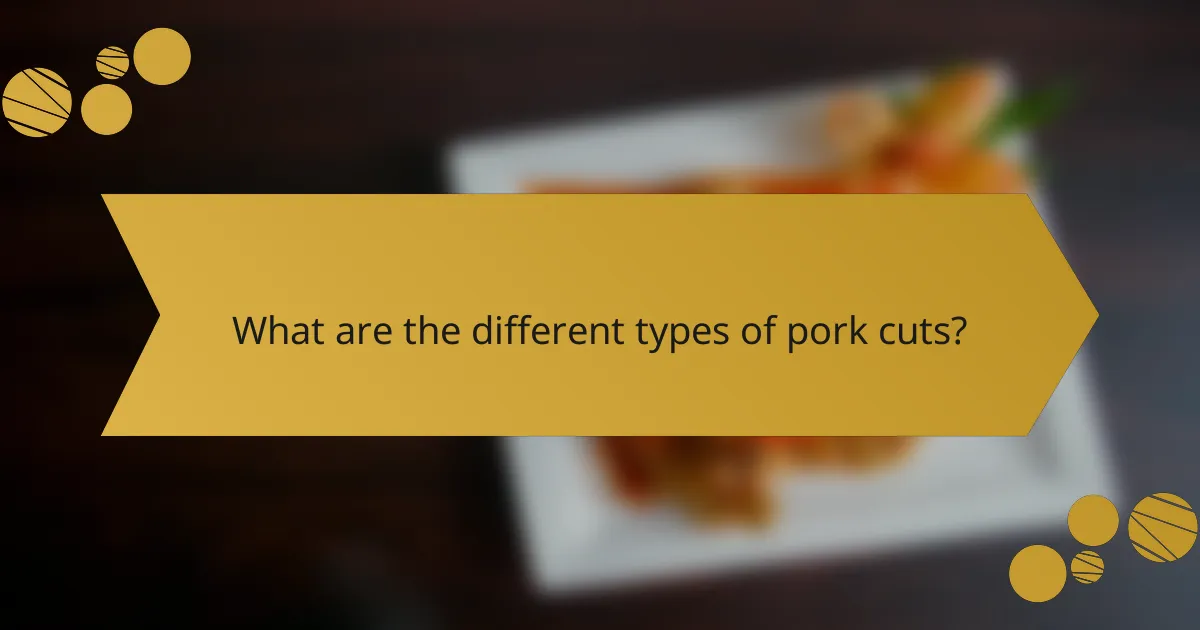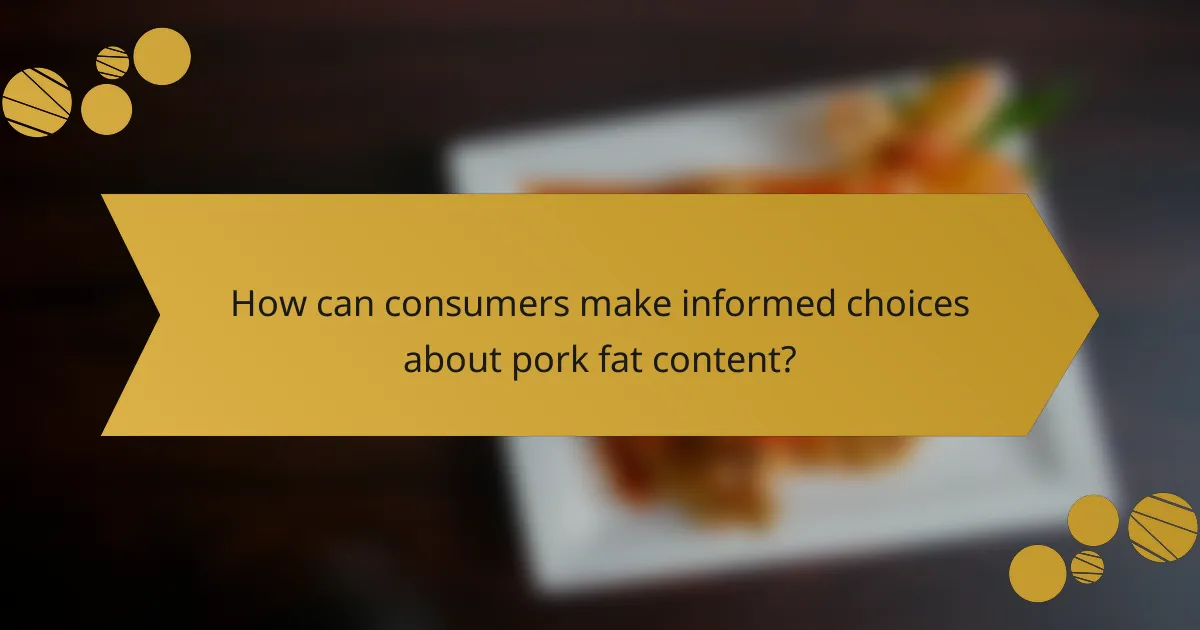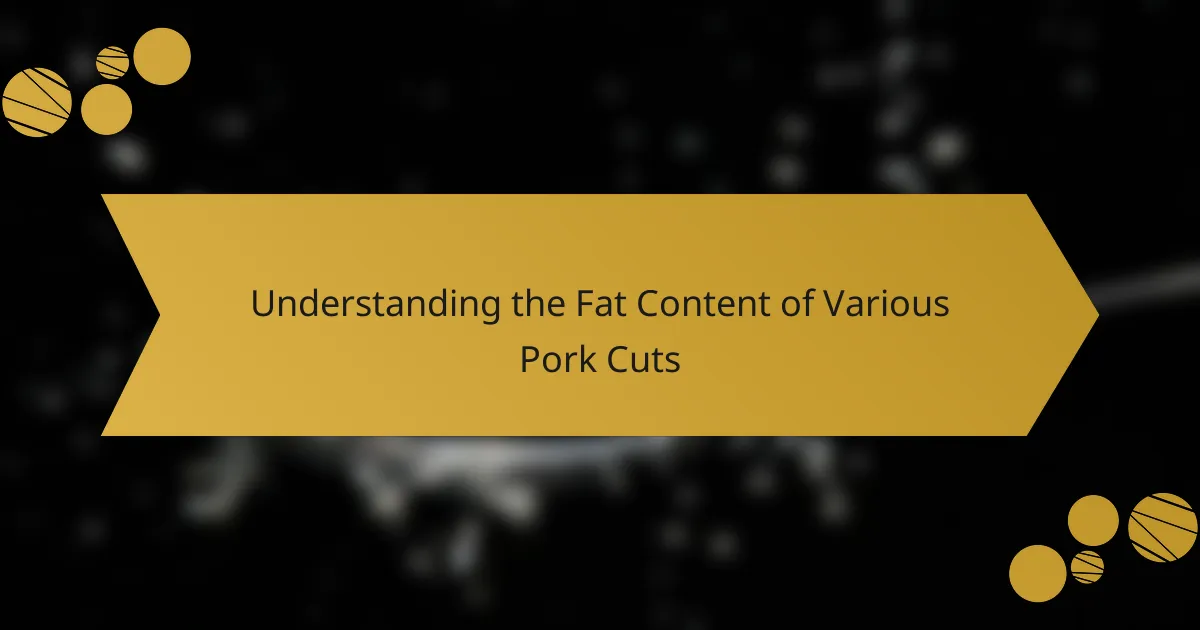
What is the fat content of various pork cuts?
Pork cuts have varying fat content depending on the specific cut. For example, pork belly contains approximately 37 grams of fat per 100 grams. Pork shoulder has about 20 grams of fat per 100 grams. Pork loin is leaner, with around 10 grams of fat per 100 grams. Tenderloin is even leaner, offering about 3 grams of fat per 100 grams. These values indicate that different cuts provide different levels of fat, affecting their culinary uses and health considerations.
How is fat content measured in pork cuts?
Fat content in pork cuts is measured using several methods. The most common method is through laboratory analysis, specifically using a technique called ether extraction. This method involves weighing a sample of the pork cut, then using a solvent to extract the fat. After the extraction, the remaining sample is weighed again. The difference in weight indicates the fat content.
Another method is the use of near-infrared spectroscopy (NIR). This technique analyzes the light reflected off the meat to estimate fat content without the need for chemical solvents. It provides quick results and is increasingly used in commercial settings.
The USDA also provides guidelines for fat content in pork cuts. They classify cuts based on their fat percentage, which helps consumers understand what to expect. For example, pork cuts labeled as “lean” must have less than 10 grams of fat per 3.5 ounces.
These methods ensure accurate measurement of fat content, aiding in nutritional labeling and consumer choices.
What are the standard metrics used for measuring fat content?
The standard metrics used for measuring fat content include percentage by weight, total fat grams, and saturated fat grams. Percentage by weight indicates the proportion of fat relative to the total weight of the food item. Total fat grams provide a direct measurement of fat in a serving size. Saturated fat grams specify the amount of saturated fat within the total fat content. These metrics are commonly found on nutritional labels. The USDA FoodData Central provides detailed nutritional information that includes these metrics for various food items.
How do cooking methods affect fat content measurements?
Cooking methods significantly influence fat content measurements in food. Different techniques, such as frying, grilling, and roasting, can alter the amount of fat retained or rendered from the meat. For instance, frying typically increases fat content due to the absorption of cooking oil. Conversely, grilling allows fat to drip away, reducing overall fat content.
Research indicates that cooking methods can lead to variations in fat retention by as much as 40% depending on the technique used. A study published in the Journal of Food Science found that boiling pork resulted in lower fat content compared to frying, highlighting the impact of cooking methods on fat measurements.
Additionally, the temperature and duration of cooking play crucial roles. Higher temperatures can render more fat, while longer cooking times may lead to further fat loss. These factors collectively determine the final fat content measurement in cooked pork cuts.
Why is understanding fat content important for consumers?
Understanding fat content is important for consumers because it influences health, taste, and cooking methods. Fat contributes to the flavor and juiciness of meat. Different cuts of pork have varying fat levels, affecting their nutritional profile. For example, pork belly has a higher fat content than pork tenderloin. Consumers aiming for healthier diets may choose leaner cuts with less saturated fat. The American Heart Association recommends limiting saturated fat intake to reduce heart disease risk. Understanding fat content helps consumers make informed dietary choices. This knowledge can also assist in meal planning and preparation techniques.
How does fat content influence health and nutrition?
Fat content significantly influences health and nutrition by affecting energy intake and nutrient absorption. Dietary fats provide essential fatty acids and help in the absorption of fat-soluble vitamins A, D, E, and K. However, excessive saturated fat intake can lead to increased cholesterol levels and cardiovascular disease risk. The American Heart Association recommends limiting saturated fat to less than 6% of total daily calories. Conversely, unsaturated fats, found in foods like avocados and nuts, can improve heart health. Research indicates that replacing saturated fats with unsaturated fats can reduce heart disease risk by up to 30%. Understanding fat content in foods, particularly in pork cuts, is crucial for balanced nutrition and health management.
What role does fat content play in flavor and cooking quality?
Fat content significantly influences flavor and cooking quality in pork cuts. Higher fat content enhances flavor by providing richness and depth. Fat acts as a carrier for flavor compounds, making dishes more savory. Additionally, fat contributes to moisture retention during cooking. This helps prevent drying out, especially in lean cuts. The melting of fat during cooking creates a juicy texture. Studies show that well-marbled pork cuts are preferred for their taste. For instance, the USDA reports that marbling correlates with higher consumer satisfaction. Thus, fat content is crucial for both flavor enhancement and cooking performance.

What are the different types of pork cuts?
Pork cuts are categorized into several types based on the part of the pig from which they are derived. Common types include loin, shoulder, belly, ham, and ribs. The loin cut is known for its tenderness and is often used for chops and roasts. The shoulder cut is fatty and ideal for slow cooking and pulled pork. Pork belly is rich in fat, used for bacon and other dishes. Ham comes from the hind leg and is often cured or smoked. Ribs, including spare ribs and baby back ribs, are popular for grilling and barbecuing. Each cut has distinct characteristics that influence its cooking methods and flavor profiles.
How do various pork cuts differ in fat content?
Pork cuts vary significantly in fat content. Cuts like pork belly have a high fat content, often around 50% fat. In contrast, pork tenderloin is very lean, containing about 3% fat. Other cuts, such as pork shoulder, have a moderate fat content, typically around 20-30%. The fat content influences cooking methods and flavor profiles. For instance, fatty cuts are ideal for slow cooking, while lean cuts are better for grilling. Understanding these differences helps in selecting the right cut for specific recipes.
What are the leanest pork cuts available?
The leanest pork cuts available include pork tenderloin, pork loin chops, and pork sirloin. Pork tenderloin is one of the leanest options, containing about 3 grams of fat per 3-ounce serving. Pork loin chops also offer a low-fat choice, with approximately 5 grams of fat per serving. Pork sirloin, while slightly higher in fat, still remains a lean option with around 7 grams of fat per serving. These cuts are recommended for those seeking lower-fat meat options.
Which pork cuts are considered the fattiest?
The fattiest pork cuts include pork belly, pork shoulder, and spare ribs. Pork belly is known for its high-fat content, often used for bacon. Pork shoulder has a good amount of marbling, making it flavorful and juicy. Spare ribs also contain significant fat, contributing to their tenderness. These cuts typically have higher fat percentages compared to leaner cuts like pork loin or tenderloin.
What factors influence the fat content in pork cuts?
The fat content in pork cuts is influenced by several factors. These factors include the breed of the pig, diet, age at slaughter, and specific cut of meat. Different pig breeds have varying genetic predispositions to fat deposition. For instance, heritage breeds typically have higher fat content than commercial breeds. The diet of the pig greatly affects its fat composition. Pigs fed a diet rich in energy will have higher fat levels. Additionally, older pigs tend to have more fat compared to younger ones. Lastly, certain cuts, such as the belly, naturally contain more fat than leaner cuts like the loin.
How does the breed of pig affect fat content?
The breed of pig significantly influences its fat content. Different pig breeds have varying genetic predispositions for fat deposition. Breeds like Berkshire and Duroc are known for higher intramuscular fat, resulting in marbled meat. In contrast, breeds such as Yorkshire tend to have leaner meat with lower fat content. Research has shown that the fat content can vary by as much as 10% between breeds. Additionally, factors like diet and environment also play a role, but breed remains a primary determinant. Studies indicate that the genetic makeup of a breed is crucial in establishing its fat characteristics.
What impact does diet have on the fat composition of pork?
Diet significantly impacts the fat composition of pork. The type of feed given to pigs influences the levels of saturated and unsaturated fats in the meat. For instance, a diet rich in grains tends to produce pork with higher unsaturated fat content. Conversely, a diet high in protein and omega-3 fatty acids can lead to pork with a better fatty acid profile. Research indicates that pasture-raised pigs, which consume grass and foraged foods, often have higher levels of beneficial omega-3 fats. Studies show that the fat composition can shift notably depending on the dietary sources, affecting both flavor and nutritional value.

How can consumers make informed choices about pork fat content?
Consumers can make informed choices about pork fat content by examining product labels and understanding the nutritional information. Labels typically indicate the fat content per serving size. Consumers should look for the total fat, saturated fat, and trans fat values. Lean cuts of pork, such as loin or tenderloin, generally contain less fat. Research shows that pork fat content varies significantly among different cuts. For example, pork belly has a higher fat content compared to pork chops. Additionally, cooking methods can affect fat content. Grilling or baking pork can reduce fat compared to frying. By selecting leaner cuts and using healthier cooking methods, consumers can manage their intake of pork fat effectively.
What tips can help in selecting pork cuts with the desired fat content?
To select pork cuts with the desired fat content, examine the marbling in the meat. Marbling refers to the small flecks of fat within the muscle. Higher marbling indicates a richer flavor and tenderness. Look for cuts labeled as “shoulder” or “belly” for higher fat content. Leaner options include “loin” or “tenderloin.” Check the color of the fat; white fat is generally preferred for quality. The USDA grading system can also guide fat content expectations. Cuts graded as “Prime” typically have more fat than those graded as “Choice” or “Select.”
How can cooking techniques help manage fat content in meals?
Cooking techniques can significantly help manage fat content in meals. Methods like grilling, baking, and steaming allow excess fat to drip away from the food. For instance, grilling pork allows fat to melt and escape, resulting in lower overall fat content. Baking at high temperatures can also reduce fat as it cooks off. Steaming preserves moisture without adding extra fat. Additionally, using non-stick pans can minimize the need for added oils or fats. Research indicates that cooking methods can reduce fat content by up to 30% when using healthier techniques. Therefore, the choice of cooking technique directly influences the fat content in meals.
What should consumers look for on labels regarding fat content?
Consumers should look for total fat, saturated fat, and trans fat on labels. Total fat indicates the overall fat content in a serving. Saturated fat should be limited to reduce heart disease risk. Trans fat is associated with increased cholesterol levels and should be avoided. Additionally, consumers should check serving sizes to understand fat content per portion. Labels may also include percentages of daily values based on a 2,000-calorie diet. Understanding these figures helps consumers make informed dietary choices regarding fat intake.
What are the best practices for cooking pork cuts with varying fat content?
The best practices for cooking pork cuts with varying fat content involve adjusting cooking methods based on the fat level. Lean cuts, such as pork loin, benefit from quick cooking methods like grilling or sautéing to prevent dryness. Cooking lean cuts to an internal temperature of 145°F ensures safety and optimal juiciness.
For medium-fat cuts, like pork shoulder, slow cooking methods such as braising or roasting at lower temperatures allow the fat to render, enhancing flavor and tenderness. Cooking medium-fat cuts until they reach an internal temperature of 190°F breaks down collagen, making the meat tender.
Fatty cuts, such as pork belly, are best suited for methods that allow for rendering excess fat, like slow roasting or smoking. This helps achieve a crispy exterior while keeping the interior moist. Cooking fatty cuts to an internal temperature of 200°F ensures the fat is fully rendered.
Using a meat thermometer is crucial for all cuts to ensure proper cooking and safety. Adjusting cooking times based on the thickness of the cut also enhances results. These practices optimize flavor and texture across different pork cuts with varying fat content.
How does cooking time vary for different fat levels in pork?
Cooking time for pork varies based on fat levels. Lean cuts of pork, such as pork loin, typically require less cooking time. They often need about 145°F internal temperature, which can take 20-30 minutes per pound. In contrast, fattier cuts like pork shoulder benefit from longer cooking times. These cuts can require 1.5 to 2 hours per pound to reach tenderness. The fat in these cuts helps keep the meat moist during the cooking process. Therefore, higher fat levels generally lead to longer cooking times to achieve optimal texture and flavor.
What methods enhance flavor while managing fat content?
Using herbs and spices enhances flavor while managing fat content. Incorporating garlic, rosemary, and paprika can add depth to dishes without additional fat. Cooking methods like grilling or roasting also enhance flavors through caramelization. These methods allow the natural flavors of pork to shine. Utilizing marinades with vinegar or citrus can tenderize meat and infuse flavor. This technique reduces the need for fatty sauces. Research indicates that seasoning with herbs can improve taste perception, making leaner cuts more enjoyable. Studies show that flavor compounds from herbs can enhance overall satisfaction with lower-fat meals.
The main entity of this article is the fat content of various pork cuts. The article provides detailed information on the fat content of different pork cuts, highlighting specific values for cuts such as pork belly, shoulder, loin, and tenderloin. It explains methods for measuring fat content, the impact of cooking techniques on fat retention, and the importance of understanding fat content for health and nutrition. Additionally, it discusses factors influencing fat composition, such as pig breed and diet, and offers guidance for consumers on selecting cuts based on fat content and cooking methods.
